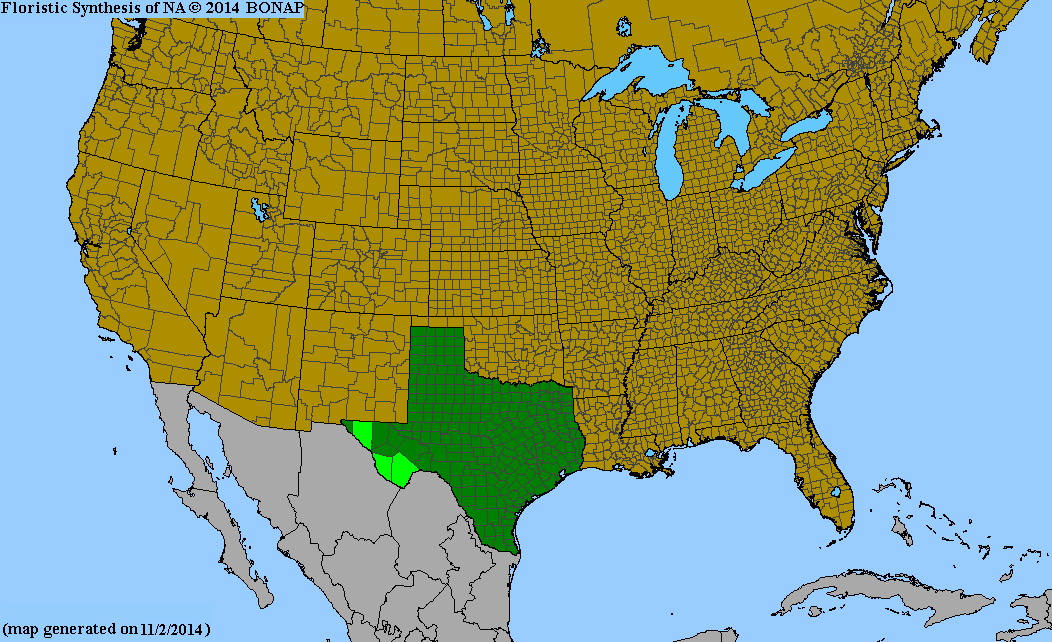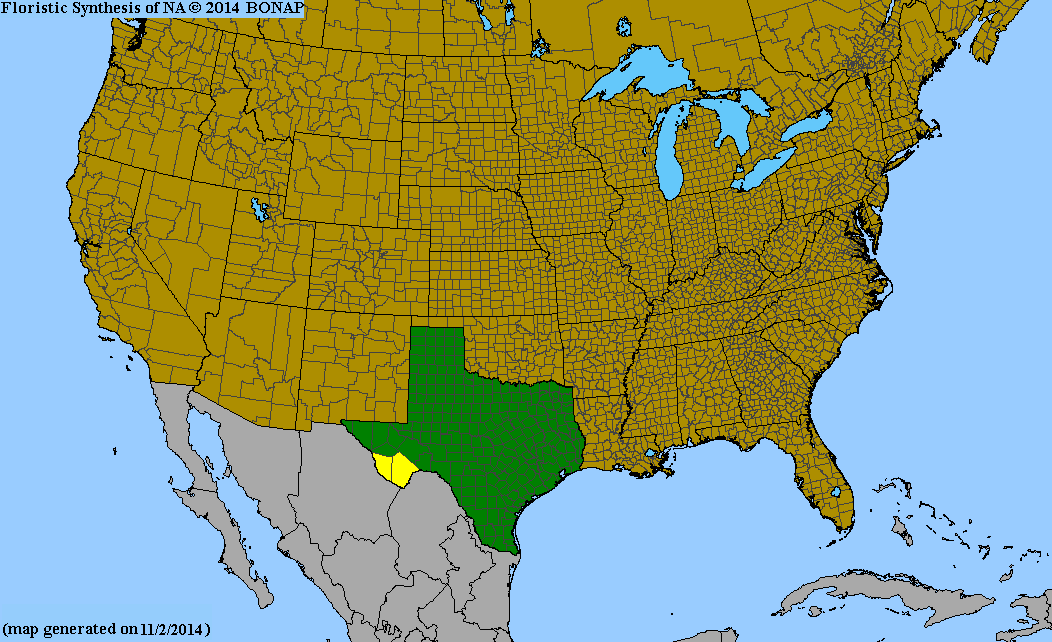Click on the images below to see larger versions.
| Scientific Name | Opuntia azurea var. parva | USDA PLANTS Symbol | N/A |
| Common Name | Big Bend Purplish Prickly Pear | ITIS Taxonomic Serial No. | N/A |
| Family | Cactaceae (Cactus) | SEINet Reference |
Click Here |
| Description | Habitat: Desert habitats only in Big Bend area from 1900 to 3700 ft. Plant: Many-branched, sprawling plant 1 to 3 ft high. Pads & Spines: Pale blue-green to bluish-gray pads, upper obovate with tapered bases, lower nearly circular, 3 to 7-1/2 inches long and up to 5-1/2 inches wide; tinged with purple especially around areoles, becoming predominantly purple during droughts. Spines in upper portion and edges of pads, 1 to 3 spines per areole up to 4-3/4 inches long (sometimes longer), black to dark red with white tips. Inflorescence: Young flowers yellow, becoming orange-red by late afternoon; up to 3-1/8 inches across; yellow filaments and anthers, cream-colored style with green stigma lobes. Bloom Period: March to May. Fruit: Pale red to purple, ovate to obovate, 5/8 to 1-1/8-inch long and up to 1 inch across. References: "Cacti of Texas" by Powell, Weedin and Powell. Notes: O. azurea not yet recognized at USDA Plants or ITIS. Previously identified here as O. macrocentra, however, according to the above reference that species does not exist in Brewster County and Big Bend. |
BONAP Distribution Map N/A |
Texas Status: Native Endemic to Big Bend area, common throughout Brewster County |
| Scientific Name | Opuntia dulcis (Opuntia engelmanni var. dulcis, Opuntia lindheimeri var. dulcis) | USDA PLANTS Symbol | OPEND |
| Common Name | Sweet Prickly Pear | ITIS Taxonomic Serial No. | 538006 |
| Family | Cactaceae (Cactus) | SEINet Reference |
Click Here |
| Description | Habitat: Desert environments along the Rio Grande from Big Bend northwest to at least El Paso; 2200 to 3500 ft. elevation. Plant: Summer: Sprawling plant up to 3 to 5 feet high. Pads & Spines: Pads obovate to suborbicular, 6 to 7 inches long, 4 to 6 inches across; usually 2 spines per areole, about 1-1/4 inches long; lower portions light brown to nearly white above. Inflorescence: Yellow flowers with pale or bright red center; 2 to 2-3/4 inches across; pale green to cream-colored or colorless filaments about 5/8-inch long, yellow anthers; colorless or pinkish style with light green stigma lobes. Bloom Period: April to May. Fruit: Smooth with a few areoles and no spines; obovate to inverse conical shape, reddish, about 2 inches long, 1 to 1-1/4 inches diameter. References: "Cacti of Texas" by Powell, Weedin and Powell. |
BONAP Distribution Map N/A |
Texas Status: Native |
| Scientific Name | Opuntia engelmannii var. engelmannii (Opuntia phaeacantha var. discata) | USDA PLANTS Symbol | OPENE |
| Common Name | Engelmann's Prickly Pear, Cactus Apple | ITIS Taxonomic Serial No. | 913651 |
| Family | Cactaceae (Cactus) | SEINet Reference |
Click Here |
| Description | Habitat: Desert habitat; dry, sandy, rocky soils from 1000 to 6000 ft., primarily in southwest Texas west of the Pecos River. Plant: Upright, spreading branches 3 to 5 feet high (higher in ideal growing conditions). Pads & Spines: Pads obovate, broadly elliptic or orbicular, 8 to 12 inches long, 6 to 10 inches across; variable spines, white or gray covering entire surface, 1 to 2 inches long, usually 1 to 4 per areole (or 0 to 5). Inflorescence: Yellow flowers without red center, becoming pale orange late in the day; occasionally orange veins on inner tepals; about 3 inches across; cream-colored to pale green filaments, yellow anthers; cream-colored style with green stigma lobes. Bloom Period: April to July. Fruit: Barrel- or oval-shaped, purple to dark reddish-purple, 2-1/4 to 3-1/4 inches long, 1-1/4 to 2 inches diameter. References: "Manual of the Vascular Plants of Texas" by Correll and Johnston and "Cacti of Texas" by Powell, Weedin and Powell. |
BONAP Distribution Map |
Texas Status: Native |
| Scientific Name | Opuntia rufida | USDA PLANTS Symbol | OPRU3 |
| Common Name | Blind Prickly Pear | ITIS Taxonomic Serial No. | 19731 |
| Family | Cactaceae (Cactus) | SEINet Reference |
Click Here |
| Description | Habitat: Desert habitats; limestone and igneous soils and rocks on flats, hillsides, canyons; from 1800 to 4000 ft. Plant: Erect shrub 2 to 5 feet high, multiple branches. Pads & Spines: Circular, obovate or elliptic, gray-green pads 3 to 10 inches across; with many spineless areoles; areoles have white to gray hairs and conspicuous reddish-brown glochids. Inflorescence: Yellow flowers becoming apricot to orange later in the day; 1-3/4 to 3 inches across; white filaments, yellow to cream colored, colorless to green style with dark green stigma lobes. Bloom Period: April and May. Fruit: Ovoid-shaped, greenish-red, 3/4 to 1 inch across; spineless. References: "Manual of the Vascular Plants of Texas" by Correll and Johnston, "Cacti of Texas" by Powell, Weedin and Powell and SEINet. |
BONAP Distribution Map |
Texas Status: Native Endemic to Big Bend area along the Rio Grande |
| Scientific Name | Opuntia spinosibacca (Opuntia X spinosibacca) | USDA PLANTS Symbol | OPSP7 |
| Common Name | Spiny-fruit Prickly Pear | ITIS Taxonomic Serial No. | 195335 |
| Family | Cactaceae (Cactus) | Flora of North America Ref. | Click Here |
| Description | Habitat: Hot, dry limestone soils of slopes and canyons of eastern portion of Big Bend National Park, 1600 to 2300 ft. Plant: Upright, compact plants 3 to 5 feet tall. Pads & Spines: Light green to yellowish green pads 4 to 8 inches long and up to 6 inches wide; often purple near areoles. Spines white with red base, becoming dark red-brown with pale tips, aging gray, 3/4 to 2-3/4 inches long; upper areoles with 4 to 8, lower with one or more. Inflorescence: Yellow flowers with red centers, 2 to 2-3/4 inches across; pale green to cream-colored filaments, anthers pale yellow, style white to pinkish, stigma lobes pale green to cream-yellow. Bloom Period: March to May. Fruit: Ovoid to obconic, greenish-yellow becoming tan to yellowish or reddish; 1 to 1-3/4 inches long, 1/2 to 1 inch across; many spines mostly around the rim, reddish brown and 1-inch long. References: “Cacti of Texas” by Powell, Weedin and Powell and Flora of North America. Notes: Previously treated as O. X spinosibacca, a hybrid of O. aureispina and O. phaeacantha. |
BONAP Distribution Map Opuntia X spinosibaca |
Texas Status: Native Endemic to small region along eastern edge of Big Bend National Park |


















